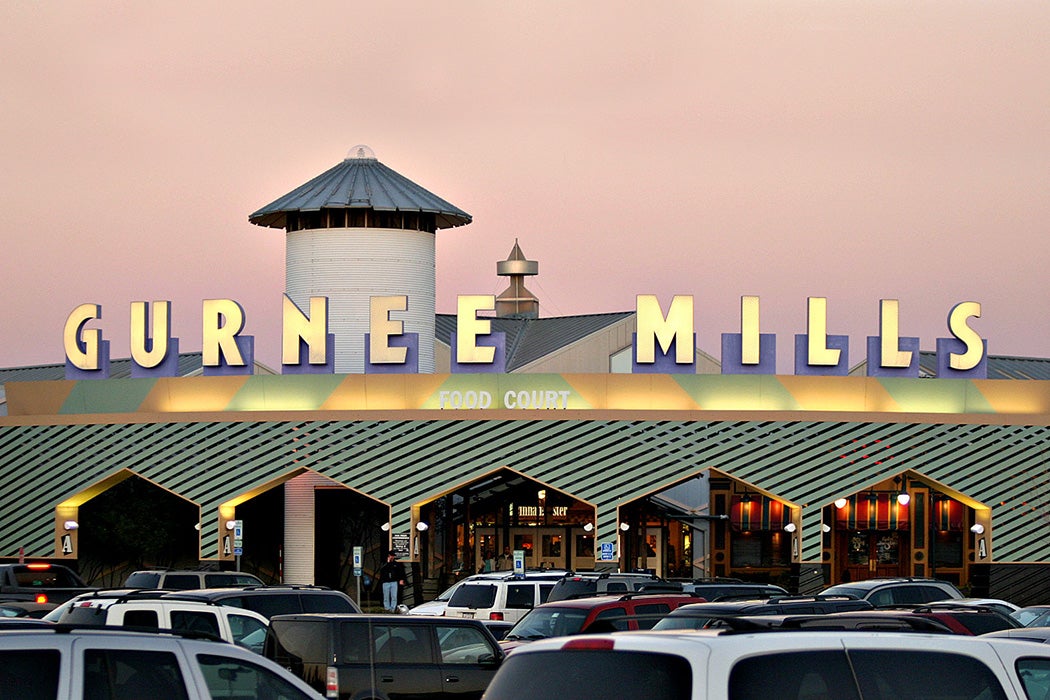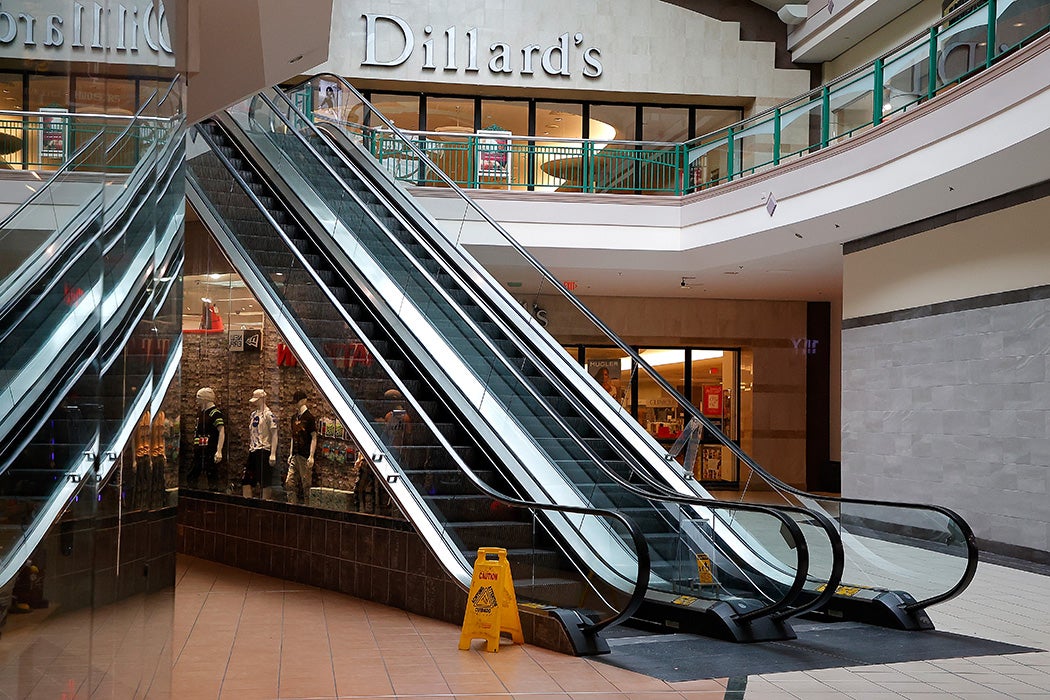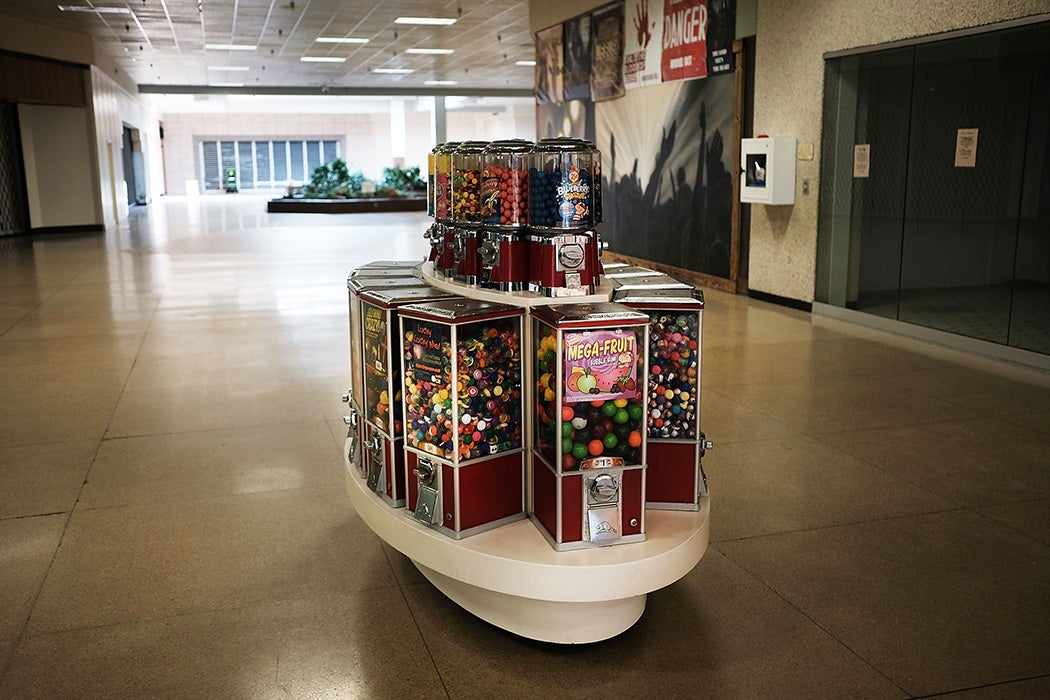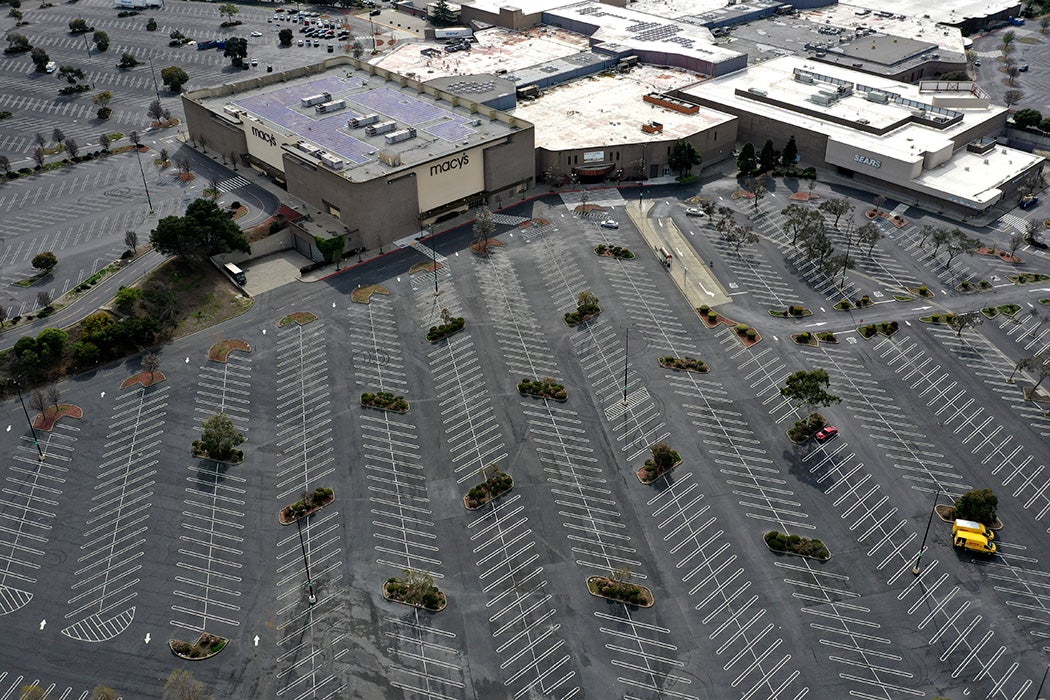Gurnee Mills is a sprawling, 1.93 million-square-foot outlet mall in Gurnee, Illinois, about 45 miles north of Chicago. In better times, it was a bustling shopper’s mecca. It underwent a $6 million renovation in 2018, and managed, in recent years, to replace its departed anchor stores, like TJ Maxx. But in 2019, citing a rise in mall vacancies and a decline in cash flow, the credit rating agency Fitch Ratings downgraded its outlook to “negative,” meaning the agency believed Gurnee Mills would be unlikely to repay its $260.3 million loan.
That loan was packaged into a commercial mortgage-backed security, or CMBS. In the process, the loan itself was divided into pieces (called tranches, French for “slices”) and sold to banks like Wells Fargo and Credit Suisse. Securities like that one are at the center of concerns about the roughly $1 trillion in debt tied to shopping malls. Gurnee Mills is an example of a nationwide phenomenon: many malls are at risk of defaulting on loans, which could pose a serious problem for the financial sector.

The International Council of Shopping Centers (ICSC), an industry trade group, recently warned that, if coronavirus restrictions mean that their tenants can’t (or don’t) pay rent, the ensuing domino effect could cause long-term damage to financial markets. Malls are in trouble as a result of the pandemic, but many were already struggling. That creates a dilemma for small towns across the country, because, as the architecture critic Philip Nobel noted in Landscape Architecture Magazine, in many places malls constitute the only public square available to citizens. Since the middle of the twentieth century, malls have taken on the role of civic center in otherwise desolate cities. Only recently has e-commerce threatened that status, driving weaker shopping centers out of business.
A wave of mall loans is set to mature in the next two years. If shopping mall owners are unable to pay off their loans, it could trigger a crisis that will lead to shuttered malls, which will in turn affect banks and pension funds that have invested in mall CMBS. Thus far, Treasury and the Federal Reserve have managed to pump enough money into the sector to avert a crisis. But as the pandemic puts more pressure on malls, additional steps may be needed to avert a disaster not unlike that seen in 2008.
The Architecture of the Problem
By May 2020, Gurnee Mills was deserted. Like so many other malls, it was closed to foot traffic due to the pandemic. Representatives for Gurnee Mills declined to comment. The mall is owned by Simon Property Group, an Indianapolis-based real-estate investment trust (REIT), the biggest shopping mall operator in America. Representatives for Simon Property Group also did not respond to questions.
About 49 mall CMBS loans, worth $4.6 billion, are set to mature this year and next, according to an April 2020 DBRS Morningstar report. Simon Property Group, together with Brookfield Property Partners, account for 65.1% of the outstanding balance of those CMBS loans.
The question now is whether mall operators like Simon will be able to restructure their loans to avoid default. By March of 2020, 31 regional mall CMBS loans, worth approximately $2.2 billion, were in special servicing. In May, Moody’s reported that loans with payments less than 30 days late rose to 8.4% of all CMBS, up from 2.4% in March; the retail sector had the highest delinquency rate.
“Lenders may find restructuring the terms of commercial loans can be an effective loss mitigation strategy,” said professor Clifford Rossi of the University of Maryland’s Robert H. Smith School of Business. “Determining an obligor’s ability to repay a restructured loan is critical to ensuring the success of any such strategy. During the 2008 financial crisis, for example, lenders faced significant redefaults on modified residential mortgages, an issue that is more pronounced in the commercial real estate sector.”
Weekly Newsletter
Total outstanding commercial real estate debt is worth about $3.66 trillion. To prevent a crisis in commercial real estate debt, industry advocates urged the Federal Reserve to include private-label CMBS in the Term Asset-Backed Securities Loan Facility (TALF), a government program created in 2008 to boost credit lending by issuing asset-backed securities. In other words, the Federal Reserve gave loans to the issuers of securities backed by auto loans, credit card loans, residential mortgage servicing advances, student loans, and Small Business Administration loans; then, the New York Fed created a special-purpose vehicle to buy those assets, with the goal being to increase liquidity in the securitization markets. In April, the Fed complied, and included commercial mortgages in the list of eligible underlying credit for asset-backed securities.
The outlook for malls like Gurnee Mills is better than that of many regional malls, according to Moody’s Associate Managing Director Robb Paltz. That’s because companies like Simon and Brookfield Property Partners have shown a willingness to invest in updates of their malls.
“Going into this crisis, we saw this divide in that the malls that didn’t do these updates were failing,” Paltz said. “Ultimately, when we come out of this, you’re going to have some very substantial holes in the rent rolls. A lot of these retailers won’t be able to make it through.”
The Role of Hedge Funds
Moody’s has put deals “on watch” due to their own exposure in the regional mall market. The malls haven’t defaulted yet, but Paltz said they’ve seen a decline in performance. The crisis for shopping malls has, predictably, been a boon to some hedge funds. Malls drew the attention of hedge funds several years ago. They got involved in the fate of malls through the securitization of mall loans.
In the years leading up to the financial crisis, securitization and the use of complex financial products, such as credit default swaps, allowed the financial sector to grow faster than gross domestic product, a team of real estate investors reported in the Journal of Real Estate Portfolio Management in 2009. Debt in the financial sector rose to 293% of GDP by the end of 2008. Financial sector liabilities also grew faster than the private non-financial sector as a whole.

In recent years, credit default swaps have made a bit of a comeback. Through these financial instruments that allow an investor to “bet against” sectors of the commercial real estate market, hedge funds are poised to profit off defaults in securitized mall loans. Furthermore, the securitization process—the creation of tranches—lets banks issue more loans. It also gives investors a higher yield than government bonds do.
In that process, mall mortgages owned by real estate investment trusts are packaged into bonds called Commercial Mortgage-Backed Securities. The loans in the CMBS serve as collateral in case of a default. The investors who own those CMBS stand to lose money if the malls default on their loans. The CMBS are then included in a commercial real estate mortgage index, which can be bet on or against by anyone, from obscure hedge funds to Goldman Sachs.
Hedge funds, such as Apollo Global Management’s hedge fund, bought credit default swap contracts that pay out when malls default on their loans. These investors are essentially betting that malls will fail, and the CMBS attached to them will drop in value. Goldman Sachs started advising clients to short or bet against, the CMBX-6, a derivatives index tied to the CMBS of shopping malls, in 2019.
Meanwhile, pension funds and asset managers like PIMCO, Putnam Investments, and AllianceBernstein have bet that malls will be able to pay their loans.
The worry is that if malls default on their loans, the value of those CMBS will drop, and the losses to bondholders like banks and pension funds will quickly mount—and then the liquidity, or ability to sell assets, in the commercial real estate debt market could freeze up.
How Does This Situation Compare to 2008?
In 2008, the marketplace for mortgage-backed securities of all types collapsed because the markets lost confidence in origination underwriting, in the rating agencies, and in the long-term performance of real estate, a team of investors and economists wrote in a 2009 article on commercial real estate debt. There was widespread fear that credit rating agencies had failed to properly rate debt securities, with even triple-A ratings coming under suspicion.
During the 2008 crisis, the default rate on commercial mortgages was a fraction of the default rate on sub-prime mortgages—1.2% versus 40%. There was no problem with the vast majority of underlying commercial real estate loans then. The CMBS loan origination market slowed to a crawl because investor confidence in debt instruments collapsed generally.
A collapse in confidence is what the Federal Reserve is trying to avert now. The trouble is, many malls and hotels may struggle to pay off their loans under current economic conditions. The International Council of Shopping Centers (ICSC) has asked the Trump administration to recognize the $1 trillion of debt underlying shopping centers. They’ve also pointed out that the government’s corporate credit facilities require borrowers to have investment-grade debt, and many shopping mall owners do not have that.
ICSC Vice President of Public Relations Stephanie Cegielski said mall operators may need to work with banks to renegotiate loan terms on their mortgages, which they may be unable to pay if their tenants stop paying rent. Many retailers have said they planned to skip rent while their businesses were forced to close due to the pandemic. In April, mall operators collected just 15% of monthly rent, according to CenterSquare Investment Management.
“[We] would like to see Congress provide a grant-based federal program to assist businesses of all sizes and from all industries,” Cegielski said. “Businesses need to have cash on hand when they reopen so they can operate and get their business started.”
She added that the biggest challenge facing mall operators during the pandemic is local or state mandates requiring businesses to close. The lost revenue for tenants becomes lost revenue for mall REITs when tenants stop paying rent.
“[Mall] landlords should prepare for a significant rise in late payments and defaults over the next couple of months,” Rossi said. “Delinquency rates on commercial real estate debt will be dominated by two factors: the speed by which states are able to reopen businesses and the degree to which consumer fears over a continuation of the virus will offset their desire to return to normal shopping habits.”

Thus far, the Federal Reserve has taken action to unfreeze markets through asset purchases and credit market facilities. Rossi added that Treasury and the Fed together have injected an unprecedented amount of liquidity into the financial system, surpassing even 2008 levels. There is stress across the board in the mall REIT sector due to the pandemic. It is unclear what will happen to malls that had viable business plans before; offline shopping may not come back for months, even as restrictions are lifted state by state. As for malls that were already struggling, the pandemic will likely speed their decline. That spells trouble for many CMBS bonds backed by mall loans.
“From a credit perspective, malls were a key driver of bond downgrades before the coronavirus outbreak, and they’ve been a driver for deals we’ve put on review for downgrade since the outbreak, just because malls, when they fail, they can see pretty substantial losses—typically mall loans are larger than others,” said Keith Banhazl, managing director of structured finance at Moody’s. “In our rated portfolio, some of the highest risk is exposure to regional malls.”
The pandemic-related shutdown of malls brought a slow-burning problem to a full boil. Unlike student loan debt, which had reached nearly $1.6 trillion in the U.S. by last year, mall REIT loans are coming due as mall operators’ funding source has been cut off. Student debt has also been securitized into student loan asset-backed securities, but there are an estimated 44 million student loan borrowers, whereas there are relatively few big players among U.S. mall REITs, so the field of borrowers is much more highly concentrated.
There are two areas of stress for malls’ balance sheets. One is the cash flow coming from retail tenants—or lack thereof. The second is the ability of the mall operator to put money back into the mall; many tenants are in multiple malls, and they won’t necessarily stick with a landlord that doesn’t invest in the mall. Another area of concern is the recent glut of interest-only loans across the entire commercial real estate sector. It’s a problem for regional mall loans, but also for all commercial real estate deals of recent vintages. Banhazl said Moody’s data shows that interest-only loans have a higher chance of default, especially at maturity.
In the lead-up to the 2008 crisis, there was an explosion of interest-only and option-adjustable rate mortgages. Those new types of mortgages proliferated between 2002 and 2006, jumping from 0.2% to 25% of total mortgage loan origination. The economists Romain Ranciere and Aaron Tornell wrote in 2011 that the effective repayment structure of those mortgages most closely resembles catastrophe bonds, which allow the bond issuer to receive funding only if specific conditions, like a natural disaster, happen—in other words, they transfer risk from one party to another.
Despite initial low payments, interest-only loans often end up costing the borrower more over the life of the loan. After the 2008 crisis, they receded from the residential market, comprising only 1% of home mortgages by 2018. Each mall is its own story, and some malls may yet survive the pandemic. There remains a significant difference between top-tier, Class A malls, and Class B and C malls. In May of 2020, Simon re-opened 77 malls across the country.
As malls begin to re-open, the question is whether shoppers will return in sufficient numbers to keep retail businesses afloat, and mall loans current.







